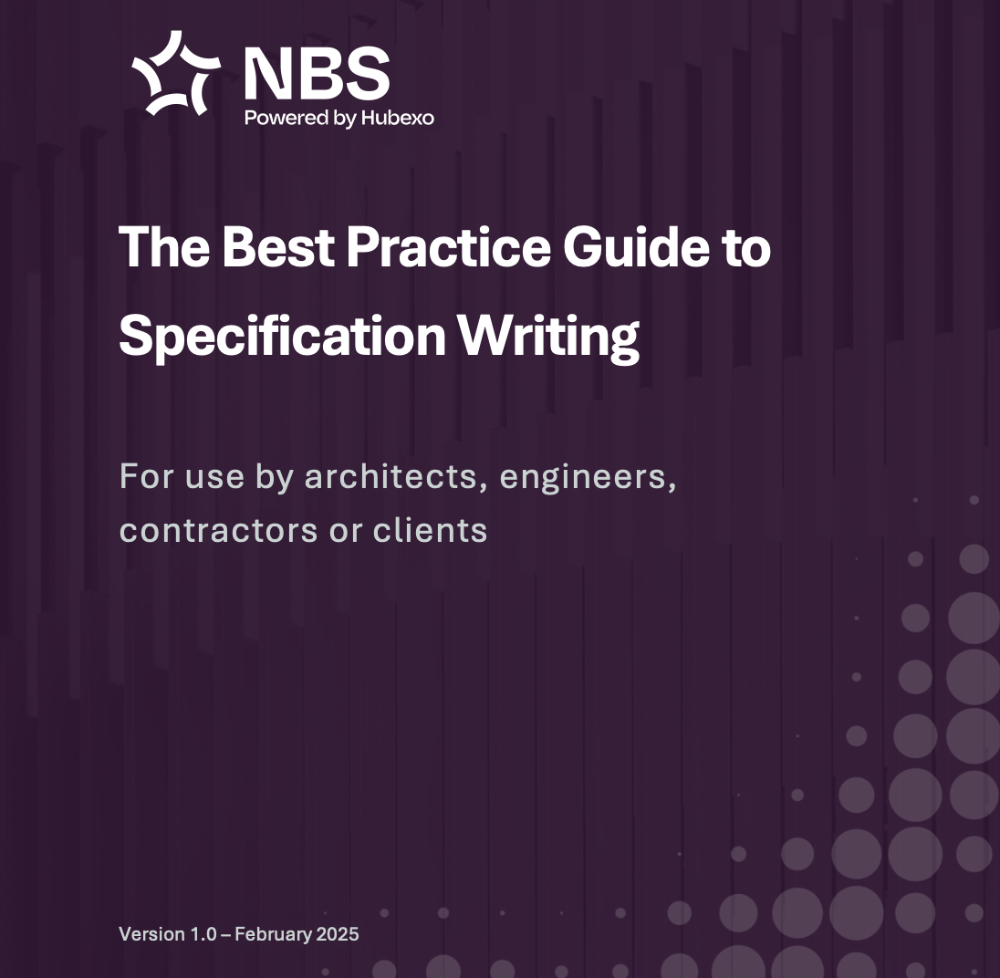NBS launches industry guide for specification writing
NBS (powered by Hubexo), the leading specification platform for the construction industry, launched The Best Practice Guide to Specification Writing, in March 2025. This is a free, comprehensive framework designed to standardise and improve specification writing across the sector. Developed in collaboration with leading industry professionals, the guide addresses common pain points, with the aim to improve consistency and quality in specifications across practices and on contractor-led projects.
Drawing on over 50 years of combined expertise from NBS and NBS Schumann, the guide distils best practice into an accessible, structured resource for architects, engineers, design managers, contractors, professional clients, and students. It provides a clear methodology for writing precise, well-structured specifications - reducing project delays, cost overruns, and compliance risks.
The development of the guide has been industry informed and built for practical use, through industry focus groups where experts highlighted widespread inconsistencies in specification writing and the need for clearer classification and change management processes. As Adrian Shilliday, Technical Director at Galliford Try, says, “Construction projects are becoming increasingly contractor-led, and inconsistency along with lack of cross discipline coordination in specification writing is a growing problem. Poorly written specs can lead to cost overruns, delays, non-compliance with regulations and safety risks. This guide provides a clear framework to prevent those issues.”
The guide is designed to empower industry professionals to write robust specifications, from those starting their careers to more experienced spec writers to reflecting on how they approach specifications. It also complements existing free resources on the NBS website, including sample project specifications.
Dr Stephen Hamil, Innovation Director at NBS and author of the guide, emphasises the document’s role in setting a universal standard: “This is a framework for writing specifications that applies across the industry. Whether you draft specifications in software, Word or on the back of a napkin, the principles remain the same. The goal is to create a standardised approach, ensuring a consistent methodology across practices and clients.”
With regulatory pressures intensifying following the introduction of the Building Safety Act, the industry must improve how it tracks and communicates specification changes. Stephen adds: “As a project progresses, it’s not just about publishing a spec and simply incrementing the revision number. It’s about highlighting precisely what clauses have changed and what those changes are. In addition, bringing as many of the specification decisions forward and ensuring full compliance is the safest route in the current regulatory climate.”
Industry leaders including 3DReid, AHMM, Bowmer + Kirkland, EPR Architects, Galliford Try, Laing O'Rourke and Purcell contributed expertise to ensure the guide reflects real-world challenges and solutions.
The guide is intentionally software-agnostic, allowing organisations to tailor it to their own processes and create a bespoke quality-assurance document. “Transparency in documentation is no longer optional; it’s expected,” says Ruth King, Specifications Lead, Allford Hall Monaghan Morris (AHMM). “Specifications must be clear, verifiable, and aligned with classification systems to ensure efficiency and consistency across teams.”
The guide also addresses manufacturer involvement in specification writing, advocating for early engagement to align product data with project requirements. “Getting manufacturers involved early is crucial. Their input ensures specifications are accurate and meet project needs from the outset,” adds Ruth.
The Best Practice Guide to Specification Writing is available for immediate download here.
This article was issued via press release and appears on the NBS news site as 'NBS launches its back-to-basics industry guide for specification writing' dated 6 March, 2025.
[edit] Related articles on Designing Buildings
- Bill of quantities BOQ
- Commissioning specification.
- Common Arrangement of Work Sections.
- Construction Specifications Canada CSC.
- Construction Specifications Institute CSI.
- Final specifications.
- Functional specification.
- Green Guide to Specification.
- Output-based specification.
- Performance specification.
- Prescriptive specification.
- Specification guidance for construction.
- Specification for construction.
- Schedule.
- Schedule of work for construction.
- Technical specification..
- Tender documentation for construction projects.
Featured articles and news
Government consultations for the summer of 2025
A year of Labour, past and present consultations on the environment, the built environment, training and tax.
CMA competitiveness probe of major housing developers
100 million affordable housing contributions committed with further consultation published.
Homes England supports Greencore Homes
42 new build affordable sustainable homes in Oxfordshire.
Zero carbon social housing: unlocking brownfield potential
Seven ZEDpod strategies for brownfield housing success.
CIOB report; a blueprint for SDGs and the built environment
Pairing the Sustainable Development Goals with projects.
Types, tests, standards and fires relating to external cladding
Brief descriptions with an extensive list of fires for review.
Latest Build UK Building Safety Regime explainer published
Key elements in one short, now updated document.
UKGBC launch the UK Climate Resilience Roadmap
First guidance of its kind on direct climate impacts for the built environment and how it can adapt.
CLC Health, Safety and Wellbeing Strategy 2025
Launched by the Minister for Industry to look at fatalities on site, improving mental health and other issues.
One of the most impressive Victorian architects. Book review.
Common Assessment Standard now with building safety
New CAS update now includes mandatory building safety questions.
RTPI leader to become new CIOB Chief Executive Officer
Dr Victoria Hills MRTPI, FICE to take over after Caroline Gumble’s departure.
Social and affordable housing, a long term plan for delivery
The “Delivering a Decade of Renewal for Social and Affordable Housing” strategy sets out future path.
A change to adoptive architecture
Effects of global weather warming on architectural detailing, material choice and human interaction.
The proposed publicly owned and backed subsidiary of Homes England, to facilitate new homes.
How big is the problem and what can we do to mitigate the effects?
Overheating guidance and tools for building designers
A number of cool guides to help with the heat.
The UK's Modern Industrial Strategy: A 10 year plan
Previous consultation criticism, current key elements and general support with some persisting reservations.
Building Safety Regulator reforms
New roles, new staff and a new fast track service pave the way for a single construction regulator.


























